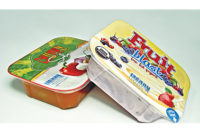
by Sandy Parlin
Advances in graphics and labeling for rigid packaging
add shelf appeal while increasing safety.
Paper or plastic? It’s not just for checkout lines any more.
The rigid packaging industry offers a wide range of choices in material, size, shape and safety options to its customers. From recycling technology already in use to implementing HACCP in packaging plants, suppliers to the rigid packaging industry employ a variety of options to meet the needs of processors that demand the best, safest and most secure packaging for dairy products combined with on-the-shelf appeal.
The rigid packaging industry offers a wide range of choices in material, size, shape and safety options to its customers. From recycling technology already in use to implementing HACCP in packaging plants, suppliers to the rigid packaging industry employ a variety of options to meet the needs of processors that demand the best, safest and most secure packaging for dairy products combined with on-the-shelf appeal.
What Processors Want
“Our (dairy processor) customers look for
innovative ideas at a minimum premium cost,” says Michael Hill, vice
president of marketing and sales for Toronto-based Polytainers Inc.
“They want improved, more eye-catching graphics that grab
consumers’ attention on crowded supermarket shelves.” Hill says
some of the “new” products offered today are actually new
adaptations of packaging technology that has been around for years.
“For example, dual-compartment containers are being used for fruit
and cottage cheese and form-fill and seal (FFS) multi-packs,” he
says. “What is new and innovative is continuously applying them to
develop new breakthrough products.”
Hill has observed a high customer demand for
lighter-weight packaging, tamper evidence, freshness protection and more
colorful and sophisticated package decoration. “Our customers are
looking for faster time-to-market with new products,” he says.
“They want just-in-time, made-to-order solutions to reduce their own
inventories and packaging.”
According to Hill, the most important requirement for
customers is that suppliers be more responsive and partner with their
customers in the new product development process.
In his presentation at last year’s International
Dairy Foods Association (IDFA) Cultured Dairy Products Conference on
packaging trends, Hill concluded that packaging fuels much of the growth
and innovation in this category. Such innovation is making products even
more appealing to consumers, he noted, and leading packaging suppliers are
partnering with processors to help take products “from concept to
consumer.”
A widespread adoption of foil or Mylar membranes
“has been in response to consumer demands for greater tamper evidence
as well as for freshness,” says Hill. “Though packaging has
gotten lighter, we have not sacrificed any packaging strength or shelf
life.”
Steve Rosse, director of marketing for Highland Park,
Ill.-based Solo Cup, says today’s dairy processors want high quality,
durable packaging with superior graphics. They favor unique sizes, shapes
and features to distinguish their products from the competition.
Rosse notes a growing trend in paperboard packaging
for dairy toward a 56-ounce non-round size, such as the increasingly
popular square-round or “scround” carton. “As with any
non-round sizes, we spend considerable time developing those growing
product areas. In other markets there is increasing customer demand for
portability to simplify their grab and go lifestyle,” he reports.
According to Rosse, customers want plastic packaging with graphic
quality approaching that possible when using paper. Solo offers state-of-the-art,
10-color graphic capabilities to respond to industry trends in novelty packaging
that include customized color containers and lids, and clear containers that
give consumers a clear look at the dessert inside.
Michelle Schmitt, marketing supervisor at Evansville,
Ind.-based Berry Plastics Corp., says today’s rigid packaging
customers want unique packages at reduced-ounce capacities, which provide a
consistent or greater profit when ingredient costs rise. “The
volatility of the resin market has certainly presented a challenge to
plastic packaging manufacturers,” says Schmitt. “Lightweight
tamper-resistant containers continue to drive innovation.”
Customers also want crisp, vibrant graphics. New
innovations include in-mold labels; thermoformed non-round packaging in 16-
and 32-ounce containers; injection-molded, tamper-resistant square
packaging in 16- and 48-ounce sizes; and clear plastic containers.
Finnish manufacturer Huhtamaki provides the dairy
industry with rigid packaging from its U.S. headquarters in De Soto, Kan.
Glenn Emory, the firm’s director of business development, says tamper
evidence is a value-added feature for processors.
“Customers seek metal-free facilities and
packaging, as well as clear packaging to reveal the value of the product.
They also require image-enhancing packaging to appeal to the premium and
superpremium segment,” says Emory, pointing to an increasing at-home
consumption of novelty items.
Among new innovations, Emory names integrated
tamper-evident designs (tamper-evident lid or cup-lid combination), clear
polypropylene plastic packaging and in-mold labels for graphic. He adds
that the 56-ounce fill volume for ice cream, versus the old half gallon, is
the new standard. “Processors either are there or are evaluating
going there,” says Emory.
While extended shelf life is a lesser concern for
frozen desserts, Emory says Huhtamaki can address such needs as they arise.
“For those individual products requiring more protection (typically
for ultraviolet light), we develop singular solutions to allow successful
market introductions of the products,” he says.
In “The Latest and Greatest Ice Cream
Packaging,” a presentation he made at the recent International Ice
Cream Association technology conference in Phoenix, Emory discussed
emerging business trends such as the seasonal nature of products; the
impact of cost increases of ingredients like vanilla, cocoa and butterfat;
and consumer demand for expensive inclusions. “I really think these
impacts are driving package selection as to material and fill-volume
size,” he says.
Regarding specific packaging trends, Emory says cost
versus benefit remains supreme, with integrated tamper evidence,
co-branding and cartoon tie-ins also ranking high. Demands for multi-packs
and reduced portion sizes for ice cream and cultured dairy products are
joined by heightened on-the-go convenience sought by today’s
multitasking consumers. In the supply chain, Emory sees product
sophistication driving an equipment and packaging link, and mutual reliance
rather than vertical consolidation among suppliers and consumers.
“While the economy struggled through 2003, we
see a healthy rebound thus far in 2004,” says Emory. “The
economy has not affected our investment in next-generation packaging nor
our pace of commercializing projects. That said, our preferred method of
new product investment is through collaborative development programs with
our customers.”
According to Emory, suppliers previously leaned toward
paper for materials and design, but that has given way to a preference for
plastic. The use of upright display freezers at points of purchase has
driven design, which features front-panel billboards for maximum display of
the packaging’s graphic elements. That has led to the development of
impact graphics including embossing and debossing, direct print and post
labels. For in-mold labeling (IML), suppliers use both smooth and textured
finishes. For graphics on paperboard cartons, users request flexography,
lithography and hot stamping as well as thermochromatic and food-contact
inks.
What Suppliers Offer
Solo, which recently acquired Sweetheart Packaging, is
a supplier of plastic and paper packaging containers and makes thermoform
plastic containers, injection-molded products and containers. In addition
to providing packaging to its customers, the company offers sales and
leasing of the equipment necessary to fill the containers.
For frozen-foods packaging, Solo offers plastic or paper novelty
and premium rigid paper materials. Frozen and refrigerated foods options include
injection-molded premium plastic and polyethylene. Packaging for refrigerated
foods include polypropylene and Mtrene® plastic.
Solo’s Flexstyle® is made from heavy-duty paperboard. Available in many
shapes and sizes, it includes secure-fitting spiral-wound paper lids or
plastic cover-all lids, plus interlocking bottoms for strength and leak
resistance. Bottom-nested containers provide faster separation and
efficient dispensing. Solo offers a wide variety of window styles. The
company’s non-round, tapered half-gallon container provides excellent
retail space utilization. Poly-laminated printing surfaces enhance
graphics.
“Solo Cup has developed our product lines to
offer both paper and plastic packaging. This allows us to provide our
customers with packaging options that best fit their needs regardless of
substrate,” says Rosse.
Solo’s Flex-E-Form® provides an efficient,
versatile in-plant container-forming system that is expertly printed and
die-cut. The containers include polycoated sidewall blanks and bottoms. The
packaging forms a flat-bottomed, straight-walled round package.
Berry Plastics offers an extensive line of open
containers both in high-density polyethylene and polypropylene-walled
products suitable for food, dairy, frozen desserts and other applications.
A tamper-evident lid also is available. Berry offers a complete dairy
packaging line of containers, from 4 to 195 ounces.
The company’s 38mm compression-lined milk
closure solves leakage problems in the dairy case. The closure creates a
package system of tamper resistance with the blow-molded bottle. Called the
“intelligent cap,” its technology provides a forgiving seal
saving profits for dairies. “It’s the perfect marriage between
a cap and a bottle,” says Schmitt.
Huhtamaki offers the full range of in-plant formed or
preformed packaging employing either paper, plastic or combination
materials. “Our goal is the optimum cost/benefit equation tailored to
the individual customer,” says Emory. “Our breadth of material
substrates allows us to be neutral in what solution we offer. We are
confident that within our portfolio we can address most needs of the
customer.”
The company provides a variety of products for tamper
evidence and food safety. “For lid-only solutions, we developed a
proprietary/patent pending design for a tamper-evident lid. We offer the
Hinge-Lock lid — a locked-tab, living-hinge, injection-molded lid
with an in-mold label. The lid can be applied to paper or plastic
containers,” says Emory. “Another tamper-evident approach is
our integrated tamper-evident collar with mated flat-panel lid. The
key is the design and functionality of the tamper-evident gate, which
provides access to the lid for removal.”
In addition to offering its customers high-quality
packaging products, Polytainers also is responding to its clients’
concerns regarding food safety and security. The company has implemented a
HACCP program at its Toronto facility and is launching one at its expanded
Lee’s Summit facility in Kansas City, Mo. “HACCP generally is
required of food and dairy processors themselves, not their packaging
suppliers,” says Hill, “but we’ve gone the extra mile in
order to assure our processor customers the highest levels of food safety
and security from beginning to end of the process.”
Looking Ahead
Huhtamaki and other companies continue to keep pace
with industry trends and try to anticipate exactly what needs are going to
be in great demand next.
“We are undergoing a study to identify the
upcoming direction of rigid packaging. We are looking forward to the
results due out late April or early May,” says Emory.
“We’re going to see a trend toward thermoforming and toward
smaller single-serve containers.”
Emory forecasts continued improvement in package
design and graphics and a persistent trend towards more colorful, impactful
packaging. “We’ll see better labeling, more sleeving and
in-mold labeling and more use of pigments in the basic containers
resins,” he says.
Emory also anticipates an increase in strategic
partnering between packaging suppliers and their customers and more total
supply chain linkage between buyers and suppliers.
“It is no longer sufficient to consider just the price of the
container — logistics, total system costs and time-to-market take on ever-increasing
importance,” he says. “These areas for non-product innovations and improvements
will affect us all in the future.”
Sandy Parlin is a freelance journalist based in the Chicago
area.
$OMN_arttitle="Rigid Needs Flexible Suppliers";?>

